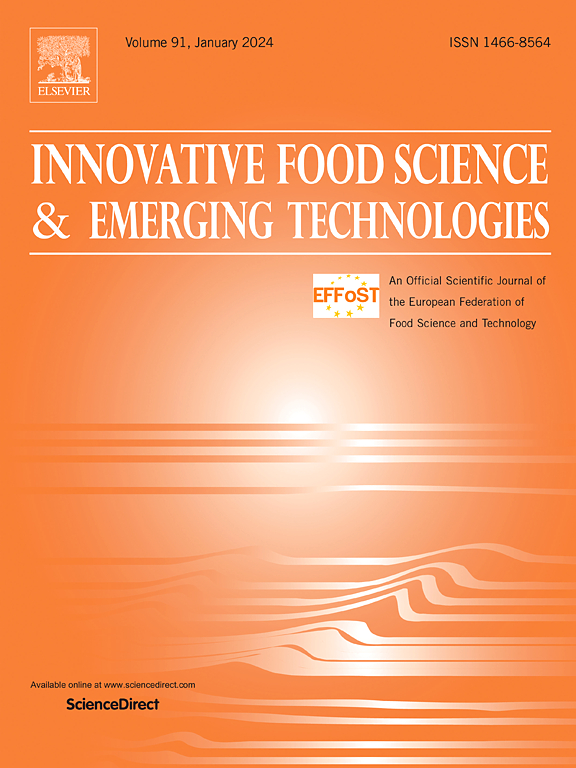交变磁场预处理对玉米淀粉分子结构和理化性质的影响
IF 6.3
1区 农林科学
Q1 FOOD SCIENCE & TECHNOLOGY
Innovative Food Science & Emerging Technologies
Pub Date : 2025-06-28
DOI:10.1016/j.ifset.2025.104103
引用次数: 0
摘要
磁场作为一种绿色的淀粉改性技术,越来越受到人们的关注。研究了不同强度(2 ~ 10 mT)交变磁场(AMF)对玉米淀粉分子结构和理化性质的影响。结果表明,与未处理的玉米淀粉相比,经AMF预处理的玉米淀粉表面孔隙度增大,表面凹陷更明显,直链淀粉(AM)含量降低(9.93% ~ 29.87%),平均粒径降低(3.77% ~ 8.74%)。所有样品均保持典型的a型晶体结构,一定的AMF强度增强了淀粉的相对结晶度(RC)(5.59% ~ 22.86%)和分子有序度。此外,处理后的淀粉具有较高的热稳定性和较低的粘度和吸油性能。综合分析表明,当磁场强度为8 mT时,AMF的处理效果最为显著。这些研究结果突出了AMF在开发低油、高稳定性淀粉方面的潜力。本文章由计算机程序翻译,如有差异,请以英文原文为准。

Effect of alternating magnetic field pretreatment on the molecular structure and physicochemical properties of maize starch
As a green technology for starch modification, magnetic fields have been garnering growing attention. This study was designed to investigate the effects of alternating magnetic fields (AMF) at various intensities (2–10 mT) on the molecular structure and physicochemical properties of maize starch. The results indicated that, in comparison to the untreated starch, the maize starch pretreated with AMF exhibited enhanced surface porosity, more pronounced surface depression, a decrease in amylose (AM) content (9.93 %–29.87 %), and a reduction in average particle size (3.77 %–8.74 %). Moreover, all samples maintained the typical A–type crystal structure, and a certain AMF intensity enhanced the relative crystallinity (RC) (5.59 %–22.86 %) and molecular orderliness of the starch. In addition, the treated starch exhibited higher thermal stability and lower viscosity and oil absorption properties. Comprehensive analysis indicated that the treatment effect was most significant when the magnetic field intensity was 8 mT. These findings highlight the potential of AMF in the development of low-oil, high-stability starch.
求助全文
通过发布文献求助,成功后即可免费获取论文全文。
去求助
来源期刊
CiteScore
12.00
自引率
6.10%
发文量
259
审稿时长
25 days
期刊介绍:
Innovative Food Science and Emerging Technologies (IFSET) aims to provide the highest quality original contributions and few, mainly upon invitation, reviews on and highly innovative developments in food science and emerging food process technologies. The significance of the results either for the science community or for industrial R&D groups must be specified. Papers submitted must be of highest scientific quality and only those advancing current scientific knowledge and understanding or with technical relevance will be considered.

 求助内容:
求助内容: 应助结果提醒方式:
应助结果提醒方式:


